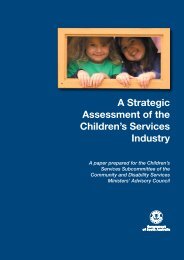Global Study On Child Poverty And Disparities (PDF) - Social Policy ...
Global Study On Child Poverty And Disparities (PDF) - Social Policy ...
Global Study On Child Poverty And Disparities (PDF) - Social Policy ...
Create successful ePaper yourself
Turn your PDF publications into a flip-book with our unique Google optimized e-Paper software.
Another issue in Vanuatu is the language of<br />
instruction; bilingualism is enshrined in the<br />
Constitution and the draft National Language<br />
<strong>Policy</strong>. While maintaining French language<br />
instruction in schools is considered an asset, it is a<br />
challenge to provide instruction in both languages<br />
because of the duplication and inefficiencies in<br />
rural areas and the lack of qualified teachers.<br />
<strong>Child</strong> outcomes, disparities and<br />
gender equality<br />
Approximately three-quarters (74 per cent) of<br />
primary-school-age children are enrolled; only 63<br />
per cent reach grade 5, and less than 3 per cent<br />
of children who enrol in primary school make it<br />
through to year 13 (ADB 2009a). The literacy rate<br />
is also relatively low, estimated at 74 per cent and<br />
69 per cent in rural areas. Vanuatu also has the<br />
highest proportion of children in the Pacific who<br />
have never attended school. Some areas have<br />
as high as 65 per cent non-attendance rates, and<br />
there are also high rates of drop-outs, withdrawals<br />
and absenteeism. These Figures suggest<br />
Vanuatu has little chance of reaching the MDG of<br />
education for all by 2015 (ADB 2009a).<br />
As Figure 3.8 shows, school attendance rates<br />
differ substantially with differences in mother’s<br />
education and wealth index quintiles. While 61 per<br />
cent of children whose mothers have no education<br />
are attending primary or secondary school, the<br />
rate is nearly 90 per cent for children whose<br />
mothers have secondary or higher education. Net<br />
school attendance increases from 73 per cent in<br />
the poorest wealth quintile to 89 per cent in the<br />
richest wealth quintile.<br />
Figure 3.8: School attendance rates by mother’s<br />
education and wealth quintile (%)<br />
100<br />
89<br />
89<br />
90<br />
81<br />
77<br />
80<br />
73<br />
70<br />
61<br />
60<br />
50<br />
40<br />
30<br />
20<br />
10<br />
0 None Secondary Primary Poorest Middle Lowest<br />
Mother’s Education<br />
Wealth quintile<br />
Source: MICS 2007.<br />
Table 3.8 shows the percentage of children<br />
of primary school age attending primary or<br />
secondary school. Nationally, 80 per cent of boys<br />
and girls attend primary or secondary school. By<br />
region, Tafea has the lowest net attendance rate<br />
at 70 per cent, and Malampa has the highest at<br />
93 per cent.<br />
Table 3.8: School attendance by region and age, 2007<br />
Male Female Total<br />
Background characteristics<br />
% attendance* Number of % attendance* Number of % attendance* # of children<br />
children<br />
children<br />
Region Tafea 71.7 145 68.9 132 70.4 277<br />
Shefa 82.8 122 82.7 104 82.7 226<br />
Malampa 93.1 87 93.2 88 93.1 175<br />
Penama 72.5 131 79.3 87 75.2 218<br />
Sanma 76.8 99 74.4 86 75.7 185<br />
Torba 77.5 138 82.2 146 79.9 284<br />
Port Vila 84.0 256 85.9 206 84.8 462<br />
Luganville 81.7 208 80.7 166 81.3 374<br />
Residence Urban 83.3 464 84.4 372 83.8 836<br />
Rural 79.2 722 80.1 643 79.6 1,365<br />
Age 6 72.6 225 68.2 193 70.6 418<br />
7 78.2 208 79.8 153 78.9 361<br />
8 90.0 205 87.6 160 89.0 365<br />
9 80.9 210 84.6 198 82.7 408<br />
10 78.2 154 85.6 141 81.7 295<br />
Mother’s<br />
education<br />
11 80.9 184 82.4 170 81.6 354<br />
None 59.4 104 62.2 111 60.8 215<br />
Primary 79.4 661 82.1 527 80.6 1,188<br />
Secondary + 89.2 246 89.3 225 89.3 471<br />
Non-standard (*) 7 (*) 2 (*) 9<br />
Mother not in<br />
84.8 168 78.7 147 82.0 315<br />
household<br />
Missing/DK . 0 (*) 3 (*) 3<br />
66
















